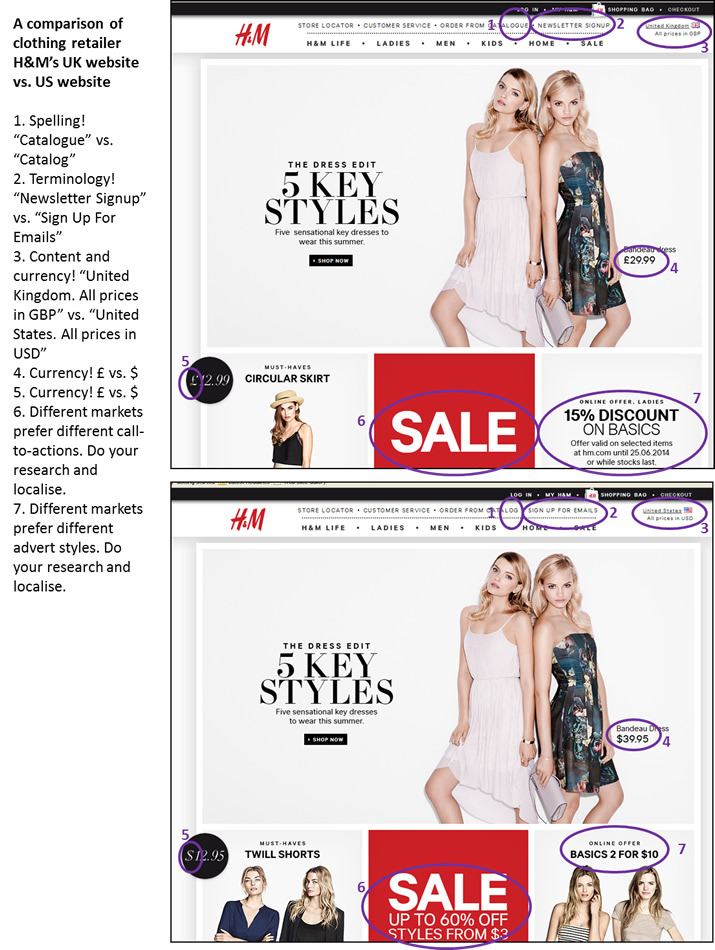So, you think your new international website content has what it takes to launch your business to global success? Sure, your content may be of a high quality from a purely linguistic point of view, but it is not quite as simple as just rustling up some content in your target language and slapping it online. Creating good international content is not just about the language, you need to make sure that all aspects are localised.
What is localisation, I hear you ask? Localisation is the process of adapting your content so that it is perfectly suited to its specific target country/region. Language is the obvious place to start but good localisation goes way beyond this. There are many different facets to localisation and many otherwise high quality articles can fall at the final hurdle by failing to localise all these different elements. Why? Because localisation is what anchors a piece of writing in a specific context and fosters trust with readers from your specific target country/region.
Confused or intimidated about how to practically go about the important task of localising your international content? Do not be, it is actually quite straightforward – I even made this handy checklist!
1. Currency
What currency do they use in your target market? You need to make sure that all prices on your website are in the correct currency. It is no use pricing all your items in British pounds if your target country uses dollars, Euros or yen.
2. Measurements
Do they use imperial or metric measurements in your target country? It is important that you get it right as using the wrong measurements will simply cause confusion or worse put your target audience off altogether if they believe your content is not targeted at them. The table below displays measurements in both imperial and metric.
3. Terminology

Different countries use different words to mean the same thing, even when they supposedly speak the same language. In Britain, the word “autumn” is used to describe the third season of the year (pictured above). In America, however, this season is known as “fall” – so promoting your “autumn sale” in the States is a marketing campaign doomed to fail. It is not just English that changes as you cross the Atlantic Ocean either – Portuguese also displays differences between its European and Brazilian versions, as does Spanish between its homeland Spain and its siblings in South America.
4. Spelling
Spelling variations are also common between otherwise similar languages. Let’s compare British English and American English again as an example. Whereas in Britain we would write “colour” and “localisation”, Americans would drop to the letter “u” from “colour” and change the “s” in “localisation” to a “z”, making it “color” and “localization”. These spelling deviations may seem like tiny things but they can make a big difference. If a Brit were to go onto a website where everything was written in American English, they may well simply leave as they will assume it is not targeted at them.
5. The content itself
It can be a difficult task to decide what your international content should actually be about. It is a good idea to work with a native from your target country to brainstorm content topic ideas to use as a basis for your content marketing efforts. One of your top considerations should be relevance. If you have high quality existing content it can be tempting to simply translate it into your new target language. If you are considering this, a word of caution: some subjects (such as law, healthcare, tax and education systems) are very country-specific and in these cases your existing content will probably not be relevant to your new target market. It is all very well and good creating an article about the NHS (National Health Service) in Britain but this content is meaningless in all countries other than the UK. Similarly, an article about the law in England and Wales would be completely inapplicable overseas. Some content simply is not suitable for other markets, so do not try to force it – it will not work. The best content is that that has been well-researched and written from scratch by a native. This ensures that your content is fully relevant to your local target market.
6. Colloquialisms and clichés
It is good to give your copywriter specific advice on what to include, especially when it comes to target keywords, but make sure to avoid instructing them to include colloquialisms or clichés as these are almost always country/language specific and do not transfer well into international content. Talking about something being “a piece of cake” or “easy as pie” (two common English colloquialisms) will simply leave your international audience confused as to what on earth you are talking about.
7. Law

This is a very important one. Things that are legal in your country (such as gambling and pornography) may be illegal in your target market, so make sure to check this beforehand.
8. Culture
There are many different cultures and attitudes around the world and it is very important that your content is sensitive to and appropriate for your target market’s culture. Some content that may be acceptable in your market may be deemed offensive in more conservative or religious cultures.
9. Images
Localisation is not just about text, you need to localise your images too. If you are a British business expanding into China and all your existing images show predominately white models, you may want to create new images that more accurately display the ethnic makeup of China. You also need to take into consideration and respect cultural factors such as modesty – is it acceptable to have images of holidaymakers in their swimwear, or a woman with her hair or shoulders showing, in your target market? For more information on why you should include images as part of your marketing efforts, feel free to check out my previous post on the importance of images in content marketing.
Spot the localisation!
So, now you know what international content localisation is, but what does it actually look like on a website? Below is my comparison of the clothing retailer H&M’s UK and US sites, with the localised elements circled in purple along with some numbered notes explaining exactly what is going on.
So, ready to get localising?
And there you have it – 9 simple tips for localising your international content. Creating localised multilingual content need not be difficult, sure it takes time and effort but the payoff of successfully breaking into your new target market makes it well worth it. Good luck!











One Response
Hi Elin
Great article. I know you were worried about the effectiveness being lost on non-British English speakers but as an American I got a lot out of this. The one term that tripped me up was “holidaymaker”. Vacation is the comparable American term and this speaks to your point that the localization process goes beyond language and depends on context.
Jim